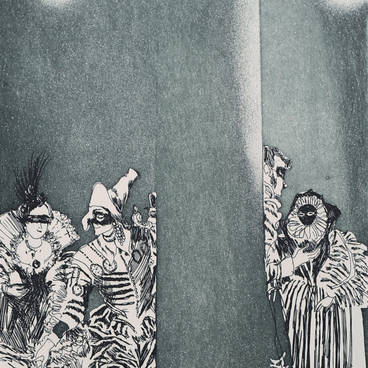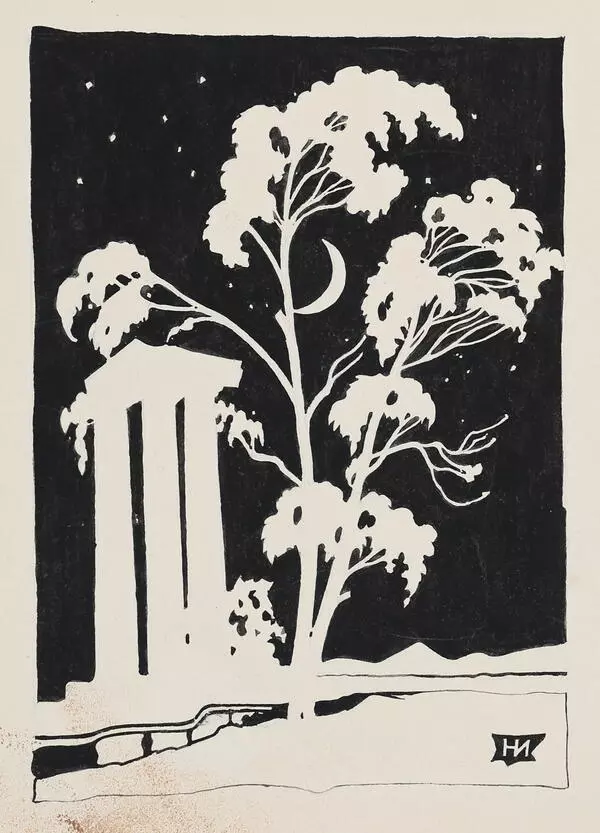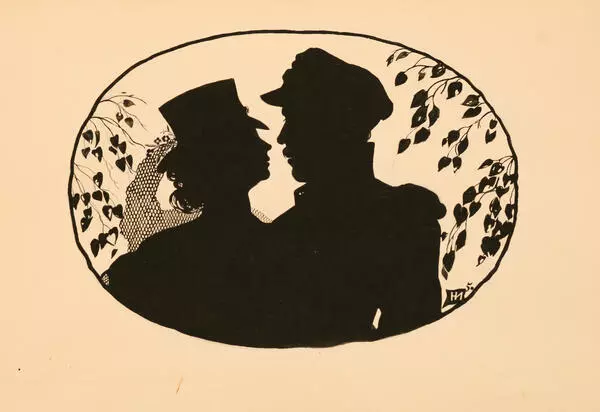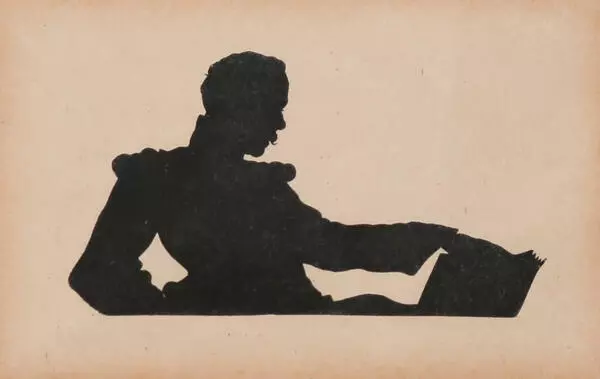In this engraving, Nikolay Vasilyevich Ilyin depicted Mikhail Lermontov from the right to the left of the spread. The poet is portrayed wearing an overcoat with a fur collar, a sleeveless cape, and a shako — a cylindrical military cap made of heavy leather with a flat top, a visor, and a chin strap.
The artist places Lermontov’s black silhouette on the right side of the drawing. The poet is depicted in Saint Petersburg after his first exile ended. He walks along the railing of the Neva embankment. The drawing shows a view of Saint Isaac’s Cathedral which is still being restored from the building of the Twelve Collegia. To the left of it and closer to the shore are the buildings and the Admiralty pavilion.
Against the white background of the Neva is a visible black pattern of the railing. Nikolay Ilyin depicted the wrought iron rings of the railing, and he embellished the higher section of it with the meander — a pattern with straight lines and right angles. The drawing is not framed and occupies the entire page, and the black pedestal on the left makes the image complete.
Mikhail Lermontov returned to Saint Petersburg from his first exile in 1838. He elaborated on that period in his letter to Mariya Lopukhina, “I plunged into the Beau Monde. For a month, I was a novelty much sought after. All those whom I have mocked in my poems now flattered me ceaselessly. Nonetheless, I am longing to leave. I asked to be sent to the Caucasus but they refused because they do not want me to get killed.”
On February 16, 1840, in the house of Countess Laval, Lermontov was challenged to a duel by Ernest de Barante, the son of the French diplomat. For participating in that duel, the poet was again exiled to the Caucasus. His last visit to Saint Petersburg took place in late March — early April of 1841, during a leave of absence. In April 1841, he left Petersburg, and this time it was for good.
In 1933, Nikolay Ilyin portrayed the period of Mikhail Lermontov’s life between January 1838 and March 1840, that is, before the poet was arrested. The work was printed in the 1941 edition called “Mikhail Lermontov. Life and Art” and in “Mikhail Lermontov. Poetry” in 1958. The original drawing was purchased from the artist’s son in 1978.
The artist places Lermontov’s black silhouette on the right side of the drawing. The poet is depicted in Saint Petersburg after his first exile ended. He walks along the railing of the Neva embankment. The drawing shows a view of Saint Isaac’s Cathedral which is still being restored from the building of the Twelve Collegia. To the left of it and closer to the shore are the buildings and the Admiralty pavilion.
Against the white background of the Neva is a visible black pattern of the railing. Nikolay Ilyin depicted the wrought iron rings of the railing, and he embellished the higher section of it with the meander — a pattern with straight lines and right angles. The drawing is not framed and occupies the entire page, and the black pedestal on the left makes the image complete.
Mikhail Lermontov returned to Saint Petersburg from his first exile in 1838. He elaborated on that period in his letter to Mariya Lopukhina, “I plunged into the Beau Monde. For a month, I was a novelty much sought after. All those whom I have mocked in my poems now flattered me ceaselessly. Nonetheless, I am longing to leave. I asked to be sent to the Caucasus but they refused because they do not want me to get killed.”
On February 16, 1840, in the house of Countess Laval, Lermontov was challenged to a duel by Ernest de Barante, the son of the French diplomat. For participating in that duel, the poet was again exiled to the Caucasus. His last visit to Saint Petersburg took place in late March — early April of 1841, during a leave of absence. In April 1841, he left Petersburg, and this time it was for good.
In 1933, Nikolay Ilyin portrayed the period of Mikhail Lermontov’s life between January 1838 and March 1840, that is, before the poet was arrested. The work was printed in the 1941 edition called “Mikhail Lermontov. Life and Art” and in “Mikhail Lermontov. Poetry” in 1958. The original drawing was purchased from the artist’s son in 1978.









